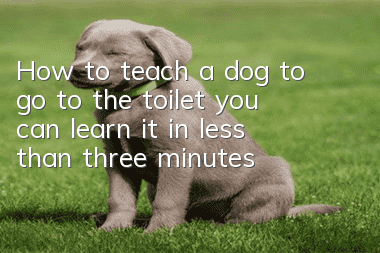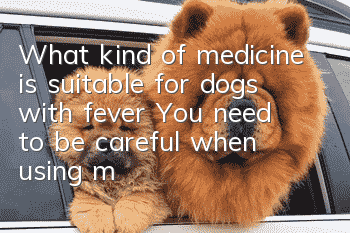How to keep your pet dog healthy

Parasites commonly found in cats and dogs include fleas and cattle ticks. Intestinal parasites include tapeworms, hookworms and roundworms, which can transmit diseases and affect the health of humans and animals. It can be effectively prevented by taking anti-parasitic drugs regularly and using drops, etc. The frequency of anti-parasitic treatment depends on the instructions of different products.
1. Regularly protect hair and mouth
Your pet's coat should be combed regularly and trimmed as necessary to avoid tangled hair; cats and dogs have thin skin, so be careful not to damage the skin when shoveling; bathing should not be too frequent, depending on the actual situation. Cleaning your pet's mouth daily is the best way to prevent dental disease. In addition, your pet's mouth should be checked regularly by a veterinarian.
2. Injections and physical examination
Vaccination is a very important disease prevention measure. Dogs over five months old only need to be vaccinated against rabies in accordance with the law, and then a booster dose is given every three years. Puppies and kittens receive three mixed doses, followed by an annual booster. When injecting boosters every year, you can ask your veterinarian to check on your pet’s physical condition.
3. Dressing up is enough
Dressing your pet depends on your needs. Long-haired, thick-haired, and large breeds are less likely to be afraid of the cold. Some newborn, old, sick, or miniaturized cats and dogs may be afraid of the cold, but you need to take your temperature to know for sure. Does it need to be kept warm? If your pet has a low temperature, wrapping it in a towel with a hot water bottle to keep it warm will be more effective than wearing clothes, because the pet may not be used to wearing clothes. There is no need for pets to wear accessories as they may injure themselves when struggling or moving. The skin of cats and dogs is thin and sensitive, so they should not be bathed frequently. Hair dyeing and bleaching should be avoided as much as possible. Use special lotion for cats and dogs when bathing.
4. Take a walk and exercise every day
Dogs only need to go out for a walk every day. It is recommended to go for a walk twice a day for thirty minutes each time. In addition to exercise, walking also allows the dog to see different people, dogs or objects. It also stimulates the sense of smell and hearing and satisfies social interaction. need.
Cats are generally kept indoors. If the cat is not too nervous outside, you can also take it out for a walk and explore different things. If the cat is not used to going out, the owner can also play games with it at home to encourage it to run, jump and Capture and other actions, increase exercise, and maintain physical and mental health.
5. Encourage natural behavior
Cats and dogs living in the wild have a natural behavioral pattern. If the behavior is suppressed, it may lead to other more serious behavioral or emotional problems. Therefore, pets should be encouraged to vent their behavior through acceptable channels.
In reality, dogs are likely to chase cars or runners on the street, causing dangerHowever, this behavior is due to the hunting nature of dogs. It is recommended that owners teach dogs to chase waves or other toys, so that the dog's desire to chase can be vented without harming people. Cats like to sharpen their claws, so place more scratching posts at home and teach them to sharpen their claws in the right places to reduce damage to objects in the house.
6. Newborn social training
Proper social training when cats and dogs are young will help them accept the things around them more easily, reduce stress caused by the environment, and they will live happier lives. The socialization period for cats is eight to ten weeks after birth, and for dogs it is only twelve to sixteen weeks. During this period, cats and dogs have high learning abilities and are receptive to new things. Owners can allow them to happily interact with different people, animals, objects and sounds. wait.
7. Smell training three times a week
It is recommended to give dogs sniffing training three times a week to satisfy them with olfactory stimulation and at the same time train concentration and attention. The method is to place several objects with special smells that the dog has not touched, such as old books, towels of other cats and dogs, etc., on the ground, allowing it to sniff and explore freely.
8. Daily interactive games
The main function of games is to train and enhance the relationship between owners and pets, and also to make pets move more. It is recommended that dog owners play three different games with their dogs every day, such as different obedience training, climbing tunnels, picking up toys, etc.
9. Happy training method
Dog training should be a happy thing. Only then will the dog have a good relationship with its owner and be willing to listen to the owner's orders. Therefore, dogs should be trained using positive reward methods, which are rewards for doing the right behavior. It is not recommended to use beatings and scolds. . For example, when a dog sees its owner pouring dog food, it may be so excited that it scratches and bites the owner. Then wait until the dog calms down and sits down before giving food as a reward for not scratching or biting.
10. Classical conditioning reduces fear
Owners sometimes need to do things to their pets that they are afraid of, such as bathing, cutting nails, taking away its food and resources, etc. These fears will put pressure on them. If they try to force their pets to accept it by beating and scolding, it will make them even more afraid. fear. It is recommended that the owner reduce the fear through classical conditioning, that is, using food to make the dog have positive associations with these behaviors.
11. No more than four hours of alone time
Dogs are social animals, so being alone for long periods of time may affect their mood. It is generally not recommended to leave dogs alone at home for more than four hours a day. Young dogs only need to be accompanied for longer periods of time to meet their social needs. Cats are relatively independent, but it is not recommended to keep them for long periods of timealone time.
12. Quality communication
Cats and dogs need enough social interaction. Of course, the longer the owner and pet spend together, the better. The quality of the time spent together is also important. If the owner is at home for a long time but only surfs the Internet, it will not be of much use. Interactive interactions with pets can include training, games, grooming, walking, etc., which can help strengthen the relationship between the two parties.
- When should puppies be vaccinated?
- What's the matter with dogs not getting fat after eating?
- Dog keeps panting rapidly
- What to do if a dog swallows a foreign object
- Bichon Frize training tips, poop shovelers should keep them in mind!
- How to keep dogs away from body odor
- Four ways to make your Pitbull strong and powerful, tips for training Pitbulls that novices must read!
- How to deal with corneal inflammation in dogs
- Reasons for Tibetan Mastiff hair loss and common sense of care
- What food is better for Teddy to eat during menstruation?



